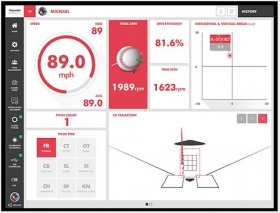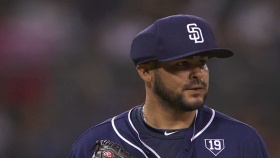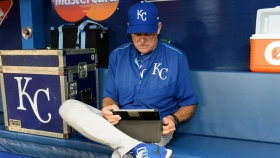Difference between revisions of "Technology in Baseball"
(Fixed grammatical errors throughout the wiki, added Protective Gear and MLB/Apple iPad deal sections, and added pictures and fixed overall formatting) |
|||
| Line 1: | Line 1: | ||
| − | Baseball has been dominated by analytics for years | + | Baseball has been dominated by analytics for years and new technological developments have proven to have an immense impact on the nature of the game. New stats and algorithms have changed how players are evaluated and have allowed players to completely revamp their careers along with changing the way the game is played. |
== History == | == History == | ||
| − | Bill James initiated the baseball analytical movement in 1982 with his book titled ‘’The Bill James Baseball Abstracts.’’<ref name = "bill"> James, Bill. ''Bill James Historical Baseball Abstract''. Villard Books, Random House, New York, NY, 1985. </ref> The book offered a different perspective on analyzing the outcomes of each baseball “event” and jump-started | + | Bill James initiated the baseball analytical movement in 1982 with his book titled ‘’The Bill James Baseball Abstracts.’’<ref name = "bill"> James, Bill. ''Bill James Historical Baseball Abstract''. Villard Books, Random House, New York, NY, 1985. </ref> The book offered a different perspective on analyzing the outcomes of each baseball “event” and jump-started baseball's fascination with numbers. James realized there was value in the static nature of baseball; the idea that each pitch and subsequent play is separate and can be recorded. He was the first to take advantage of the enormous quantity of information a game of baseball produced. This initial movement materialized in the form of multiple new stats used to evaluate players. <ref name = "bill"/>. |
Billy Beane was the next catalyst in the movement when he revolutionized the game with the Oakland A’s in the early 2000s by valuing stats like on base percentage over batting average. <ref name = "moneyball"> Lewis, Michael. ''Moneyball''. W.W. Norton, 2011. </ref> Beane built off of the work of James by prioritizing numbers and recorded results over the traditional eye test of mechanics and body types. Beane’s success, accompanied by the documentation of his story by Michael Lewis, influenced a lot of other teams to start hiring more analytical minds. | Billy Beane was the next catalyst in the movement when he revolutionized the game with the Oakland A’s in the early 2000s by valuing stats like on base percentage over batting average. <ref name = "moneyball"> Lewis, Michael. ''Moneyball''. W.W. Norton, 2011. </ref> Beane built off of the work of James by prioritizing numbers and recorded results over the traditional eye test of mechanics and body types. Beane’s success, accompanied by the documentation of his story by Michael Lewis, influenced a lot of other teams to start hiring more analytical minds. | ||
| Line 12: | Line 12: | ||
=== Rapsodo === | === Rapsodo === | ||
[[File:Pitching-Analytics.jpg|280px|left|thumb| A sample output on a Rapsodo machine.]] | [[File:Pitching-Analytics.jpg|280px|left|thumb| A sample output on a Rapsodo machine.]] | ||
| − | Rapsodo is a leading company in | + | Rapsodo is a leading company in sport analytics technologies. They specialize in machines used for tracking movements of baseballs, softballs, and golf balls. In baseball, they have two separate machines with exceptionally high-quality cameras able to track things like spin rate, launch angle, and much more. The machines are each specialized for tracking pitches or batted balls. <ref name = "rapsodo"> Rapsodo: https://rapsodo.com/ </ref> In general, these machines are used more often by pitchers than hitters. |
=== HitTrax === | === HitTrax === | ||
| − | HitTrax is another popular company in | + | HitTrax is another popular company in baseball for producing supplemental data on player performance. It condenses many of the capabilities of the Rapsodo machine into one device with an emphasized focus on collecting hitting metrics. It can calculate metrics such as the impact power and break of a pitch, but also offers simulation technology that allows players to simulate results in smaller spaces like batting cages. <ref name = "hittrax"> HitTrax: https://www.hittrax.com/</ref> |
| + | |||
| + | |||
| + | |||
| + | |||
== Player Improvement == | == Player Improvement == | ||
[[File:bauer.jpg|300px|right|thumb| Trevor Bauer, one of the top pitchers in baseball right now is famous for embracing analytics.]] | [[File:bauer.jpg|300px|right|thumb| Trevor Bauer, one of the top pitchers in baseball right now is famous for embracing analytics.]] | ||
| + | [[File:Mlb-protective-helmet.jpeg|280px|right|thumb| Pitcher wearing protective helmet]] | ||
These technologies have proven to have huge benefits for player improvement. With so much data available, players have been able to tweak very specific things in their mechanics to drastically change results. Trevor Bauer is one of the most popular examples of a pitcher using this technology to improve their performance. He, along with many others, have started to use machines from Rapsodo to increase movement on their pitches or even invent new ones.<ref name = "mvp"> Lindbergh, Ben, and Travis Sawchik. ''MVP Machine''. Basic Books, 2019. </ref> Additionally, hitters use this technology to perfect their swing mechanics. They strive for maximized exit velocity and will even change their swing path looking for a more advantageous launch angle. This technology has become integral to the professional baseball player's routine and influenced major changes in the way the game is played. The emphasis on launch angle has led to an increase in home runs, while the emphasis on pitch movement also has played a role in the increase in strikeouts. These cannot be solely attributed to the new technology available to players, but certainly played some part.<ref name = "mvp"/> | These technologies have proven to have huge benefits for player improvement. With so much data available, players have been able to tweak very specific things in their mechanics to drastically change results. Trevor Bauer is one of the most popular examples of a pitcher using this technology to improve their performance. He, along with many others, have started to use machines from Rapsodo to increase movement on their pitches or even invent new ones.<ref name = "mvp"> Lindbergh, Ben, and Travis Sawchik. ''MVP Machine''. Basic Books, 2019. </ref> Additionally, hitters use this technology to perfect their swing mechanics. They strive for maximized exit velocity and will even change their swing path looking for a more advantageous launch angle. This technology has become integral to the professional baseball player's routine and influenced major changes in the way the game is played. The emphasis on launch angle has led to an increase in home runs, while the emphasis on pitch movement also has played a role in the increase in strikeouts. These cannot be solely attributed to the new technology available to players, but certainly played some part.<ref name = "mvp"/> | ||
| + | |||
| + | == Protective Gear == | ||
| + | In response to five [[Major League Baseball]] pitchers being struck in the head by line drives in 2016, the MLB began to explore new head protection technology for its pitchers. The MLB prototyped a “hybrid of a cap and a helmet” that aimed to protect the areas of the head that are most susceptible to catastrophic injuries. The prototype was manufactured by baseball company isoBLOX and is meant to be worn under standard New Era nylon caps. <ref name = "hagen"> Hagen, P. (2016, February 12). "New head protection for pitchers on the way" </ref> The product, despite being very effective, raised doubts among its users. Dan Jennings of the Miami Marlins was one pitcher who was stuck with a 101 mph liner to the head in 2014. In an interview afterwards, he expressed that “I don’t think many guys will wear anything unless it is mandatory.” <ref name = "weinbaum"> Weinbaum, W.(2016, February 17). "Pitchers to debut new protective headwear in spring training" </ref> One focal reason being that the head technology looked drastically different than a traditional baseball cap. Jennings at the end of his interview suggested an alternative in using softer baseballs to mitigate pitcher risk. | ||
== Ethical Implications == | == Ethical Implications == | ||
| Line 28: | Line 36: | ||
Additionally, the increased use of technology has opened the doors to cheating within the sport. Multiple scandals within the last five years involving the use of technology have called for regulation when it comes to the use of technology. As is the case in many fields, as technology advances at such a high rate, regulations often have to be reactionary because the technology is so new. The MLB changed rules about live camera feeds for the 2020 season as a reaction to the Astros World Series scandal of 2017, but it was met with some backlash from players who used the technology legally in the seasons before. <ref name = "baez"> ESPN: https://www.espn.com/mlb/story/_/id/29833732/struggling-javy-baez-sounds-inability-watch-video-previous-bats-games </ref> | Additionally, the increased use of technology has opened the doors to cheating within the sport. Multiple scandals within the last five years involving the use of technology have called for regulation when it comes to the use of technology. As is the case in many fields, as technology advances at such a high rate, regulations often have to be reactionary because the technology is so new. The MLB changed rules about live camera feeds for the 2020 season as a reaction to the Astros World Series scandal of 2017, but it was met with some backlash from players who used the technology legally in the seasons before. <ref name = "baez"> ESPN: https://www.espn.com/mlb/story/_/id/29833732/struggling-javy-baez-sounds-inability-watch-video-previous-bats-games </ref> | ||
| − | + | == MLB/Apple iPad deal == | |
| + | [[File:Mlb-ipad.jpg|280px|right|thumb| Kansas City Royals Coach using an iPad]] | ||
| + | In 2016 the MLB signed a multi-year agreement with Apple to provide every team with iPad Pro tablets in an effort to assist coaching staffs with making data based decisions. <ref name = "olivarez-Giles"> Olivarez-Giles, N.(2016, March 29). "Baseball’s Latest Recruit Is an iPad" </ref> Using the iPad, teams are given the ability to take advantage of all the statistics accumulated for them in a custom app called MLB Dugout. The application is developed and maintained by MLB’s New York-based Advanced Media division alongside Apple. The data used by each team in the app is proprietary to each team, creating emphasis for baseball teams to develop their own data analytics team. This change drew similarities with the $400-million agreement between [[Microsoft]] Surface tablets and the NFL. The main difference between these agreements is that Apple will not require managers to use their iPad’s. Pirate’s manager Clint Hurdle expressed his interest in the devices but ultimately decided to not use one as he expressed faith in his coaches to relay prevalent information to him instead. <ref name = "Perez"> Perez, A.J.(2016, March 30). "MLB, Apple strike agreement: iPads in dugouts" </ref> | ||
== References == | == References == | ||
Revision as of 13:36, 19 March 2021
Baseball has been dominated by analytics for years and new technological developments have proven to have an immense impact on the nature of the game. New stats and algorithms have changed how players are evaluated and have allowed players to completely revamp their careers along with changing the way the game is played.
Contents
History
Bill James initiated the baseball analytical movement in 1982 with his book titled ‘’The Bill James Baseball Abstracts.’’[1] The book offered a different perspective on analyzing the outcomes of each baseball “event” and jump-started baseball's fascination with numbers. James realized there was value in the static nature of baseball; the idea that each pitch and subsequent play is separate and can be recorded. He was the first to take advantage of the enormous quantity of information a game of baseball produced. This initial movement materialized in the form of multiple new stats used to evaluate players. [1].
Billy Beane was the next catalyst in the movement when he revolutionized the game with the Oakland A’s in the early 2000s by valuing stats like on base percentage over batting average. [2] Beane built off of the work of James by prioritizing numbers and recorded results over the traditional eye test of mechanics and body types. Beane’s success, accompanied by the documentation of his story by Michael Lewis, influenced a lot of other teams to start hiring more analytical minds.
Technology
General comfort with stats and analytics likely played a role in the relatively quick adoption of technology to improve performance. Around 2012, new machines capable of measuring a number of different variables on a moving baseball started to emerge throughout the major league baseball scene and drastically influence the game.
Rapsodo
Rapsodo is a leading company in sport analytics technologies. They specialize in machines used for tracking movements of baseballs, softballs, and golf balls. In baseball, they have two separate machines with exceptionally high-quality cameras able to track things like spin rate, launch angle, and much more. The machines are each specialized for tracking pitches or batted balls. [3] In general, these machines are used more often by pitchers than hitters.
HitTrax
HitTrax is another popular company in baseball for producing supplemental data on player performance. It condenses many of the capabilities of the Rapsodo machine into one device with an emphasized focus on collecting hitting metrics. It can calculate metrics such as the impact power and break of a pitch, but also offers simulation technology that allows players to simulate results in smaller spaces like batting cages. [4]
Player Improvement
These technologies have proven to have huge benefits for player improvement. With so much data available, players have been able to tweak very specific things in their mechanics to drastically change results. Trevor Bauer is one of the most popular examples of a pitcher using this technology to improve their performance. He, along with many others, have started to use machines from Rapsodo to increase movement on their pitches or even invent new ones.[5] Additionally, hitters use this technology to perfect their swing mechanics. They strive for maximized exit velocity and will even change their swing path looking for a more advantageous launch angle. This technology has become integral to the professional baseball player's routine and influenced major changes in the way the game is played. The emphasis on launch angle has led to an increase in home runs, while the emphasis on pitch movement also has played a role in the increase in strikeouts. These cannot be solely attributed to the new technology available to players, but certainly played some part.[5]
Protective Gear
In response to five Major League Baseball pitchers being struck in the head by line drives in 2016, the MLB began to explore new head protection technology for its pitchers. The MLB prototyped a “hybrid of a cap and a helmet” that aimed to protect the areas of the head that are most susceptible to catastrophic injuries. The prototype was manufactured by baseball company isoBLOX and is meant to be worn under standard New Era nylon caps. [6] The product, despite being very effective, raised doubts among its users. Dan Jennings of the Miami Marlins was one pitcher who was stuck with a 101 mph liner to the head in 2014. In an interview afterwards, he expressed that “I don’t think many guys will wear anything unless it is mandatory.” [7] One focal reason being that the head technology looked drastically different than a traditional baseball cap. Jennings at the end of his interview suggested an alternative in using softer baseballs to mitigate pitcher risk.
Ethical Implications
The dominance of technology and analytics in baseball has leveled the playing field in some ways. The emphasis on numbers slightly reduces the level of bias executives might take based on a player's physical appearance. However, the technology is very expensive (a Rapsodo machine costs anywhere between $4,000 and $9,000) [3] which means it’s not very accessible. Thus, as with most technology, there exists a technological gap between communities that can use this technology and ones that can't. When it comes to Major League Baseball, this gap doesn't exist. It is much more apparent at the lower levels of the sport. For example, the larger colleges in the more profitable conferences are able to afford this machine and use it to improve their player's performance where the small Division III schools aren't. The existence of this technology has not created this gap, but it has accentuated it; making it harder for players starting at smaller schools or in lower-income communities to improve at the same rate. [8]
Additionally, the increased use of technology has opened the doors to cheating within the sport. Multiple scandals within the last five years involving the use of technology have called for regulation when it comes to the use of technology. As is the case in many fields, as technology advances at such a high rate, regulations often have to be reactionary because the technology is so new. The MLB changed rules about live camera feeds for the 2020 season as a reaction to the Astros World Series scandal of 2017, but it was met with some backlash from players who used the technology legally in the seasons before. [9]
MLB/Apple iPad deal
In 2016 the MLB signed a multi-year agreement with Apple to provide every team with iPad Pro tablets in an effort to assist coaching staffs with making data based decisions. [10] Using the iPad, teams are given the ability to take advantage of all the statistics accumulated for them in a custom app called MLB Dugout. The application is developed and maintained by MLB’s New York-based Advanced Media division alongside Apple. The data used by each team in the app is proprietary to each team, creating emphasis for baseball teams to develop their own data analytics team. This change drew similarities with the $400-million agreement between Microsoft Surface tablets and the NFL. The main difference between these agreements is that Apple will not require managers to use their iPad’s. Pirate’s manager Clint Hurdle expressed his interest in the devices but ultimately decided to not use one as he expressed faith in his coaches to relay prevalent information to him instead. [11]
References
{{{{{1}}}{{{2}}}|Pdf|Doc}}- ↑ 1.0 1.1 James, Bill. Bill James Historical Baseball Abstract. Villard Books, Random House, New York, NY, 1985.
- ↑ Lewis, Michael. Moneyball. W.W. Norton, 2011.
- ↑ 3.0 3.1 Rapsodo: https://rapsodo.com/
- ↑ HitTrax: https://www.hittrax.com/
- ↑ 5.0 5.1 Lindbergh, Ben, and Travis Sawchik. MVP Machine. Basic Books, 2019.
- ↑ Hagen, P. (2016, February 12). "New head protection for pitchers on the way"
- ↑ Weinbaum, W.(2016, February 17). "Pitchers to debut new protective headwear in spring training"
- ↑ Driveline Blog: https://www.drivelinebaseball.com/2019/01/technology-communication-future-coaching/
- ↑ ESPN: https://www.espn.com/mlb/story/_/id/29833732/struggling-javy-baez-sounds-inability-watch-video-previous-bats-games
- ↑ Olivarez-Giles, N.(2016, March 29). "Baseball’s Latest Recruit Is an iPad"
- ↑ Perez, A.J.(2016, March 30). "MLB, Apple strike agreement: iPads in dugouts"



